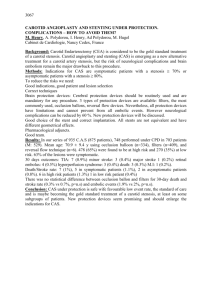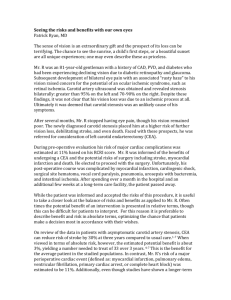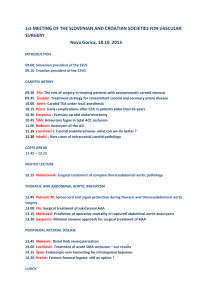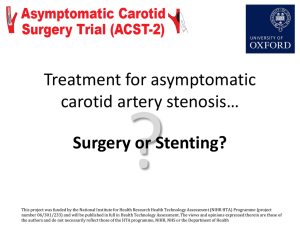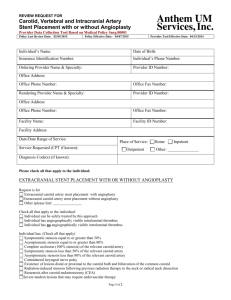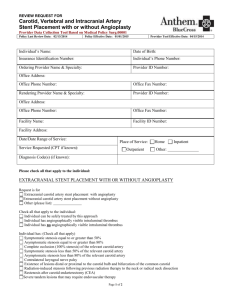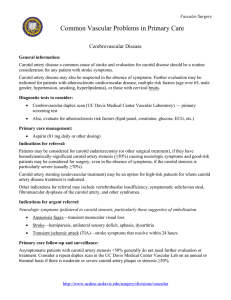I. Imaging of the Cervical Carotid Artery for Atherosclerotic Stenosis II. Authors:
advertisement
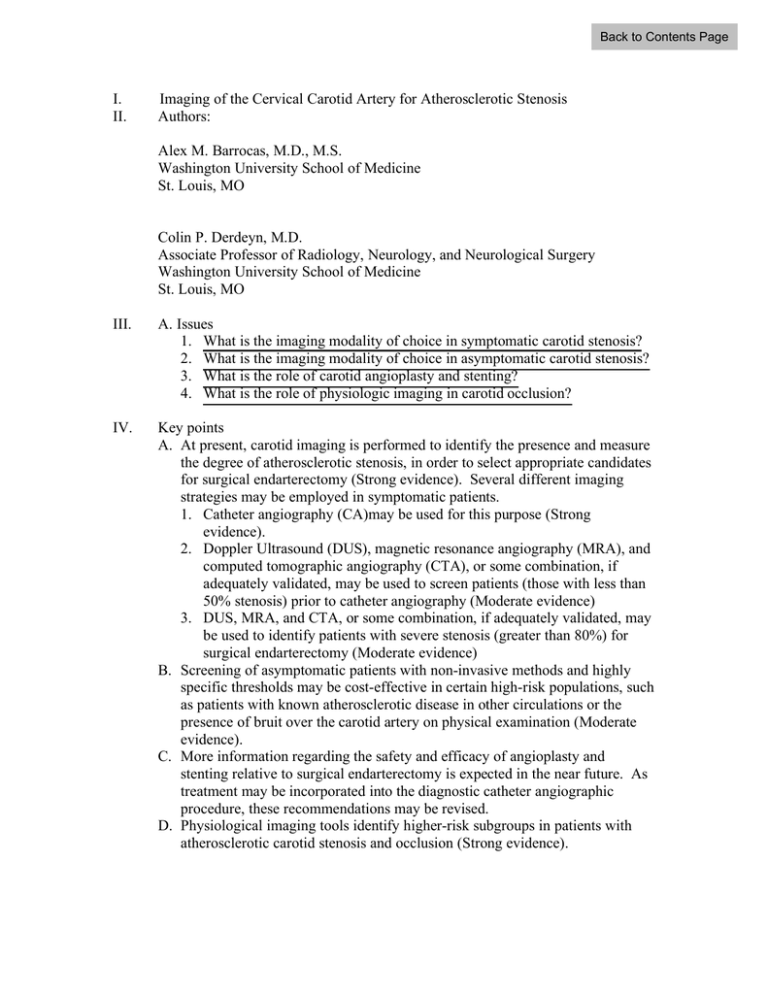
Back to Contents Page I. II. Imaging of the Cervical Carotid Artery for Atherosclerotic Stenosis Authors: Alex M. Barrocas, M.D., M.S. Washington University School of Medicine St. Louis, MO Colin P. Derdeyn, M.D. Associate Professor of Radiology, Neurology, and Neurological Surgery Washington University School of Medicine St. Louis, MO III. A. Issues 1. What is the imaging modality of choice in symptomatic carotid stenosis? 2. What is the imaging modality of choice in asymptomatic carotid stenosis? 3. What is the role of carotid angioplasty and stenting? 4. What is the role of physiologic imaging in carotid occlusion? IV. Key points A. At present, carotid imaging is performed to identify the presence and measure the degree of atherosclerotic stenosis, in order to select appropriate candidates for surgical endarterectomy (Strong evidence). Several different imaging strategies may be employed in symptomatic patients. 1. Catheter angiography (CA)may be used for this purpose (Strong evidence). 2. Doppler Ultrasound (DUS), magnetic resonance angiography (MRA), and computed tomographic angiography (CTA), or some combination, if adequately validated, may be used to screen patients (those with less than 50% stenosis) prior to catheter angiography (Moderate evidence) 3. DUS, MRA, and CTA, or some combination, if adequately validated, may be used to identify patients with severe stenosis (greater than 80%) for surgical endarterectomy (Moderate evidence) B. Screening of asymptomatic patients with non-invasive methods and highly specific thresholds may be cost-effective in certain high-risk populations, such as patients with known atherosclerotic disease in other circulations or the presence of bruit over the carotid artery on physical examination (Moderate evidence). C. More information regarding the safety and efficacy of angioplasty and stenting relative to surgical endarterectomy is expected in the near future. As treatment may be incorporated into the diagnostic catheter angiographic procedure, these recommendations may be revised. D. Physiological imaging tools identify higher-risk subgroups in patients with atherosclerotic carotid stenosis and occlusion (Strong evidence). E. The use of these physiological imaging tools to improve guide therapy and improve outcome is unproven (Insufficient evidence). A randomized clinical trial is underway for surgical revascularization of carotid occlusion in patients selected by PET. ISSUE 1: What is the Imaging Modality of Choice in Symptomatic Carotid Stenosis? Summary: At present, carotid imaging is performed to identify the presence and measure the degree of atherosclerotic stenosis, in order to select appropriate candidates for surgical endarterectomy (Strong evidence). Several different imaging strategies may be employed in symptomatic patients: Catheter angiography (CA) can be used for this purpose (Strong evidence). Doppler Ultrasound (DUS), magnetic resonance angiography (MRA), and computed tomographic angiography (CTA), or some combination, if adequately validated at the local institution with quality assurance data, may be used to screen patients for those with less than 50% stenosis prior to catheter angiography (Moderate evidence). DUS, MRA, alone or in combination, if adequately validated locally, may be used to identify patients for surgical endarterectomy (Limited evidence) DUS or MRA can be used to both screen for patients with less than 50% stenosis and reliably identify patients with severe, >80% stenosis. CA is used to investigate the degree of stenosis for the remaining patients (Moderate evidence) ISSUE 2: What is the Imaging Modality of Choice in Asymptomatic Carotid Stenosis? Summary: The benefit of surgery in patients with asymptomatic carotid stenosis is marginal. Two large randomized trials have found a 1% absolute annual risk reduction for surgery, compared to best medical therapy. Whether treatment should be pursued will depend on many factors, including patient age, gender (no definite benefit for women). In one of these two studies, restricted to highly selected, relatively healthy asymptomatic patients, 20% of the patients were dead at 5 years, many due to vascular disease. Imaging of asymptomatic patients is necessarily a screening issue. The low risk of stroke in medically-treated patients and the small risk reduction with surgery remove the harsh penalties for false-negative or false-positive non-invasive studies that are incurred in symptomatic patients. Well-validated DUS or MRA laboratories may be used for this purpose (level 2 – moderate evidence). The critical factors for screening are wellvalidated non-invasive methods and documented low surgical complication rates. Cost-Effectiveness Analysis Screening of asymptomatic patients with non-invasive methods and highly specific thresholds may be cost-effective in certain high-risk populations, such as patients with known atherosclerotic disease in other circulations or the presence of bruit over the carotid artery on physical examination. Different studies addressing the costeffectiveness of screening asymptomatic carotid stenosis resulted in divergent conclusions. The critical factor in whether intervention is effective is the surgical complication rates. A one-time screening program of a population with a high prevalence (20%) of 60% stenosis cost $35 130 per incremental QALY gained. Decreased surgical benefit (less than 1% annual stroke risk reduction with surgery) or increased annual discount rate resulted in screening being detrimental, resulting in lost QALYs. Annual screening cost $457 773 per incremental QALY gained. In a low-prevalence (4%) population, one-time screening cost $52 588 per QALY gained, while annual screening was detrimental. ISSUE 3: What is the Role of Carotid Angioplasty and Stenting? Summary: More information regarding the safety and efficacy of angioplasty and stenting relative to surgical endarterectomy is expected in the near future. As treatment may be incorporated into the diagnostic catheter angiographic procedure, these recommendations may be revised. At present, angioplasty and stenting is accepted as a reasonable therapy for patients with severe stenosis and recent ischemic symptoms who are not good surgical candidates (Level 2 – moderate evidence). Patients that are good surgical candidates should be treated surgically or within clinical trials of stenting versus endarterectomy. Noninvasive screening of symptomatic but surgically-ineligible patients for possible carotid stenosis prior to angioplasty and stenting (level 2 – moderate evidence). The benefit of angioplasty and stenting for asymptomatic patients is unproven (level 4 – insufficient evidence). ISSUE 4: What is the role of Physiologic Imaging in Carotid Stenosis and Occlusion? Summary: Physiological imaging studies – the identification of compensatory hemodynamic mechanisms to low perfusion pressure, have been shown to be powerful predictors of subsequent stroke in patients with symptomatic carotid stenosis or occlusion using some, but not all physiological imaging methods. The best evidence is for measurements of oxygen extraction fraction (OEF) with PET and breath-holding transcranial Doppler studies (Level 1 – strong evidence). There is moderate evidence (level 2) supporting the use of stable xenon CT and SPECT methods. At present, however, the use of this information to guide therapy has not been proven to change outcome (level 3 – limited evidence). The two patient populations in whom these tools are likely to become important are those with symptomatic complete carotid occlusion and asymptomatic carotid stenosis. Cost effectiveness analysis suggest that the use of these physiological tools, even expensive ones such as PET, would be cost effective for patients with symptomatic carotid artery occlusion, provided there is a benefit with surgical bypass. The costs of acute and long term care for stroke victims greatly exceeds the costs of diagnostic work up and surgery. In addition to patients with complete carotid occlusion, another promising application for hemodynamic assessment is in asymptomatic carotid stenosis. The prevalence of hemodynamic impairment in patients with asymptomatic carotid occlusive disease is very low. This low prevalence may account in part for the low risk of stroke with medical treatment, and consequently, the marginal benefit with revascularization. The presence of hemodynamic impairment may be a powerful predictor of subsequent stroke in this population. This is one area of research with enormous clinical implications: if a subgroup of asymptomatic patients at high risk due to hemodynamic factors could be identified, it would be possible to target surgical or endovascular treatment at those most likely to benefit. Only one study has been performed in this population, to date. Silvestrini, et al., performed a prospective, blinded longitudinal study of 94 patients with asymptomatic carotid artery stenosis of at least 70% followed for a mean of 28.5 months. Breathholding TCD was performed on entry, as well as the assessment of other stroke risk factors. An abnormal TCD study was shown to be a powerful and independent risk factor for subsequent stroke. Back ContentsPage Page Back to to Contents

